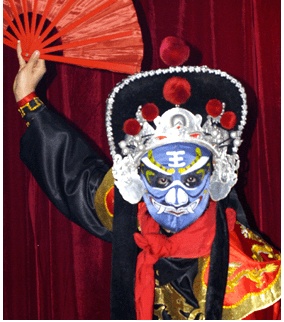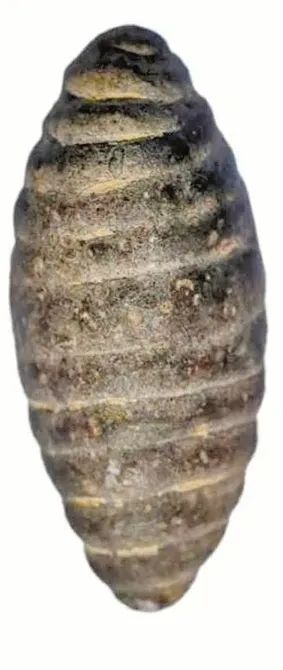[Sichuan Opera Audio] "Sichuan Opera's past and present life" Episode 15: Sichuan opera changes to face
Author:Fang Zhi Sichuan Time:2022.07.18
"Sichuan Provincial Chronicle", today I want to share with you the "wiping color change" in Sichuan opera's face -changing techniques, also known as "wiping face".
Wipe your face is a primitive and simple way to change your face. When the actor is made up, the oil color will be fixed to a certain part of the face. When the face is changed, the actor either turns around, or burys his head, or cover it with a cloak. There are also some actors who turn behind the scenes during the performance, and the color on the face changes when they appear again on the stage. There are many uses of face -changing face in the traditional Sichuan opera drama, such as "Broken Bridge", "Wang Niang Beach" and "Barnut Pillar" and other dramas. It is the most famous.

Sichuan opera's "face" of face -changing method (picture source: China Youth Broadcasting Film and Television Network)
In the curtain drama "White Snake Biography", there are a lot of plays that the white snakes and green snakes and servants appear at the same time, and they are mainly corner dramas, but "Broken Bridge" is a highlight of martial arts. In this play, the green snake was restored to men, wearing black clothes to take martial arts. The plot of "Broken Bridge" was "Water Manjin Mountain". In the battle with Fahai, the green snake turned back to the man and helped fight the white snake, but in the end, he lost because the white snake was pregnant. After the master and servant left the Jinshan Temple, they came to the broken bridge and happened to meet Xu Xian from Jinshan Temple. When the green snake saw Xu Xian, he remembered what he did. At this time, the Qing snake's face was the face, and when he heard Xu Xian's voice calling the white lady, he immediately jumped up and turned into a red face; when he grabbed Xu Xian, Xu Xian actually took off and escaped, and the move was even more angry. White snake, he threw off Xu Xian's clothes and chased Xu Xian. At this moment, his face became black; afterwards, he continued to kill Xu Xian regardless of the obstruction of the white snake. At this time, his face changed from black to it again to gold. In this wonderful chase drama, the Sichuan opera world calls it "three chases and three rushes, three changes to the body".

"White Snake Biography" stills
In this play, the three changes to the green snake expressed his irritability, and also showed his resolute character. The first change of face is blushing from the face, the second time from red to black, these two changes to the face. The actors who play the white snake use the face technique. Another kind of technique blows powder to face.
According to Mr. Wang Chengkang, an old Sichuan opera artist, the actors who played the "Broken Bridge" in the early days used the Jianghu Road. In fact, the face -changing skills were brought into the Sichuan opera in the early years. Improved and developed with the face -changing performance we are seeing now. The performance style of "Broken Bridge" is rough and hot, and the green snake reveals a primitive wildness and masculine beauty, giving the audience a strong visual impact. Although the face technique it uses is not as exquisite and beautiful as the Facebook of the face -to -face technique transformation on the stage today, it is very in line with the identity and personality characteristics of the character of the green snake, showing a long -lost grassroots consciousness and rough beauty. Unfortunately, since the late 1950s, the Sichuan opera "White Snake Biography" has basically formed the current performance path, that is, the drama is ended to "Shuiman Jinshan". "Broken Bridge" is folded, so the "Three Faces" performance in "Broken Bridge" is very rare now.

"Broken Bridge" stills
Later, this "three -faced face" performance was transplanted into the Sichuan opera "Wang Niang Beach". In the year of the drought, Nie Lang, a farmhouse, went to the mountains to cut grass. Under the guidance of a little rabbit, he picked up a Orb. After returning home, he put the orb in the rice altar. Since then, there are more and more rice in the rice altar. The mother and son no longer have to worry about the livelihood, and he can often help the neighboring folks who can't eat enough meals. After being known by the bully landlord in the village, he came to the door and forced Nie Lang's mother and son to surrender the orb. Nie Lang put it in his mouth in order to protect the Orb, but he accidentally swallowed the Orb. At this moment, his body increased rapidly and turned into a youth. When he grew up, he felt thirsty. After drinking the water at home, he still ran to the river without quenching thirst. At this time, his body continued to grow, and he also appeared. In the end, Nie Lang became a dragon. He jumped into the river to drink water, setting off a lustrous wave, and rolled away the landlord and his walking dogs who chased him. After that, the dragon jumped back and said goodbye to his mother. In the end, he went down the river and ran to the sea. He only left 24 Wang Niangtan on the river bank. This performance gave the audience a strong visual impact and emotional shock.
Bleak

Sichuan opera "Wang Niang Beach" stills
Nie Lang's face in "Wang Niang Beach" is not much different from the form of "Broken Bridge" in form, but from the analysis of the character's personality, you can see that Nie Lang from a teenager to the youth to the dragon. His psychological and personality changes. Sichuan opera's "mutual change" function can be said to be vividly reflected in this "three -face change".
In fact, in addition to "wiking the face", the most commonly used ways to change the face of Sichuan opera are: blowing powder to face, pulling lines and changing faces, etc. In the next program, we will continue to share their stories and characteristics with you.
"Sichuan Province, Sichuan Opera" shows you the charm of Sichuan opera.
This show was jointly produced by the Sichuan Provincial Local History Office and Chengdu Radio and Television Station.
Thank you "Du Jianhua Studio" Du Jianhua's special guidance!Source: Sichuan Provincial Local House Work Office

Guidance: Du Jianhua
Produced: Wang Yi
Planning: Ling Fei
Writing: Yang Rui
Host: Kwai Aoi
Picture: Fang Zhi Sichuan
- END -
The Silk carving silkworm pupae was unearthed in the Shangguo site of Wenxi County, Yuncheng

On July 15, the Shanxi Provincial Institute of Archeology released the latest arch...
Ma Siwei appeared in Panda Art Creative Exhibition Edition and humor to pay tribute to Popp art master

At 6:30 pm on July 15th, Ma Siwei, the head of the popular rapper and the original...